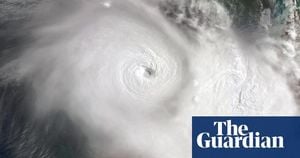Recent reports reveal significant developments concerning Russia's export activities, particularly highlighting both the promising and problematic aspects of timber and agricultural exports.
For the first time, experts from Siberian Federal University have calculated the carbon footprint of wood exports from Russia. This groundbreaking assessment, led by Anton Pyzhev, head of the Climate Change and Environmental Development Laboratory, indicates how much carbon is stored within timber sourced across various regions. Pyzhev elaborates, stating these data will eventually contribute to creating the national greenhouse gas registry necessary for tracking Russia's emissions more accurately. Until now, previous calculations relied on less detailed methods based on average coefficients from other countries.
The findings of this research were submitted to the Yuri A. Izrael Global Climate and Ecology Institute, which is responsible for developing Russia's national greenhouse gas inventory. This initiative marks a notable step toward formalizing Russia's efforts to monitor its greenhouse gas emissions linked to timber production and export.
On the flip side, illegal timber exports pose challenges to Russia's governing authorities. The Federal Security Service (FSB) border management unit in Amur Region recently uncovered attempts to smuggle over 221 cubic meters of unprocessed timber valued at more than 1 million rubles. This illegal activity was orchestrated by the 57-year-old director of a local timber trading company, who misled customs authorities with false declarations about the timber's origin and quantity.
The timber was shipped via railway through the Customs Union's border under EurAsian Economic Union regulations, marking a serious breach of law. This case has been sent to court, and the accused awaits sentencing under bail conditions. The pressure to clamp down on such illegal operations reflects both the economic significance and the environmental impact of timber exports.
While illegal exports raise red flags, the agricultural sector demonstrates growth. Reports from Buryatia outline how the region's agricultural product exports exceeded planned targets by 18% last year, facilitated by the national project titled 'International Cooperation and Export.' This has come about through investment in export infrastructure, the removal of trade barriers, and improved market promotion strategies.
Notably, Buryatia has initiated the accreditation of three veterinary laboratories to guarantee the safety and quality of its exports. Such efforts have enabled local businesses to begin exporting pork to Mongolia and have supported the successful shipment of over 9,000 horses to Kazakhstan. These developments highlight the increasing interest and demand for Russian agricultural products on international markets.
Russia's export trends indicate actions taken to strengthen economic ties globally. The national project aims to establish long-term economic partnerships and propel the growth of Russian-produced goods. The initiative, active from 2019 to 2024, reflects Russia's determination to cultivate new trade relationships even as the geopolitical climate fluctuates.
Coming back to timber, the calculated carbon emissions from timber could offer leverage for Russia to engage with its international partners. By addressing environmental concerns and illustrating improved monitoring of its timber exports, Russia can position itself as proactive on climate issues, which have been becoming increasingly important for global trade relations.
These intertwined stories of agricultural growth against the backdrop of illegal timber exports present two sides of Russia's export narrative. While growth and innovation push the boundaries for higher agricultural yields and markets, the struggle to combat illegal exports haunts the timber industry, complicates international relationships, and raises environmental concerns.
Looking forward, it remains to be seen how Russia will navigate these complex dynamics. Will the push for regulation and transparency suffice to deter illegal activities? And can the national commitment to sustainability begin to reshape timber exports in line with global climate initiatives? These are questions not merely for policymakers but for Russia's economy as it seeks to solidify its place on the world stage.



